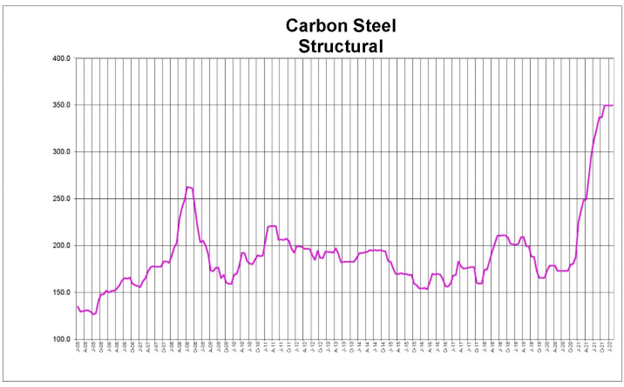WWEMA Window: Escalation And Price Adjustment Clauses — Appropriate For Use In Our Industry?
By Michelle McNish

Projects in the water environment industry typically span from one to several years and require, with few exceptions, a fixed-price bid from contractors. When establishing a product’s price, contractors must carefully consider the risks involved with possible unanticipated cost increases that may occur over the length of the project. Contracts for municipal projects typically do not include provisions for a price adjustment based on market conditions, so those projects are or should be bid with the risk of market volatility for basic materials as a deliberative consideration. Determining the premium for the risk is a problematic issue for manufacturers and contractors participating in a bidding process that is often designed to seek out the lowest price.
There are some industries, industrial being one, where it is more typical to find contracts that allow material cost increases during the project to be passed on to the owner. The cost increase of steel, aluminum, pipe, and many other commodities can be tied to an agreed-upon index in the contract. The industries that accept price adjustments based on an index in their contracts are more likely to be those that can pass price increases on to customers through the products they sell.
Since public works projects are based on receiving fixed-price bids from contractors, the risk for future, sudden, and unanticipated steep cost increases of construction materials during the project falls on the contractor and all their suppliers. Sharing the risk becomes a contentious issue between contractor and supplier. It is a matter of who is expected to accept the risk of extreme market volatility that occurs randomly.
The impact on costs and material availability due to the COVID-19 pandemic caused problems for equipment suppliers who bid for supply contracts in late 2020 and early 2021. Those bids made and later accepted for supply contracts just before the impact of the pandemic on the supply chain resulted in substantial financial losses for suppliers by the time materials and fabrication could be procured months after the bid.
Primarily during 2021, the costs of materials to manufacturers rose suddenly and far beyond normal expectations. This volatility caused manufacturers to point out the long-neglected price escalation adjustment clause that is typically found in most equipment supply proposals in other industries. Contractors who received requests for a price adjustment from equipment suppliers tried to appeal to the municipality, which quickly refused and replied with “read your contract.”
Even if agreed to, price adjustments can be complex and problematic. Perhaps for some commodities like rebar, steel plate, and pipe, the cost can be tied to an index. However, relating an index to a manufactured product that assembles several different types of components made from various materials is just not practical. The fundamental problem is that there is no way to recover the costs of a sudden market disruption of materials when a fixed price is established at the beginning of a multiyear project.
Contractors, manufacturers, and suppliers generally understand their own risks involved with delivering their products. Those risks may include the supply of materials, typical price fluctuations, available labor, and weather conditions. In ordinary circumstances, manufacturers and suppliers have a good understanding of the inputs necessary to deliver and price their products with normal risks taken into account. Those normal risks are priced in as contingency but balanced with the necessity to be competitive.
Market volatility in the cost and availability of construction materials is the normal risk that the contractor and suppliers should accept. Extreme market events are particularly devastating, as illustrated in the graph below, where the cost of some steel products (or other commodities) rises unexpectedly by 50% or even over 100% in a very short time.

Businesses that survive a financial loss due to recent pandemic-produced market conditions and a fixed price contract will be thinking hard about the amount of contingency added to their products and services going forward. Increased contingencies will add another layer of cost to the overall price for equipment and other manufactured goods. As commodity markets calm to a slower or near flat month-to-month cost increase, manufacturers may gradually reduce contingencies to remain competitive, only to get hit again by the next unexpected event some years away.
Municipalities and public works projects are protected from market risks with fixed-price contracts. Contractors and suppliers attempt to protect themselves from potential unknown future cost increases with contingencies. Will contingencies be excessive for the next few years, resulting in more costly projects for taxpayers?
Change is always difficult, but there is always a better way. The challenge for our industry is finding a way to be fair to all involved parties, including taxpayers, public works projects, contractors, and suppliers.
Suppose a method for relief, in the event of extreme price volatility, was made available. In that case, equipment suppliers and contractors could reduce contingencies and offer more competitive prices, thus reducing overall costs for municipal projects for the benefit of the taxpayers.
Michelle McNish is President at Walker Process Equipment, a Division of McNish Corporation, as well as a member of the Water and Wastewater Equipment Manufacturers Association (WWEMA) Board of Directors. WWEMA is a non-profit trade association that has been working for water and wastewater technology and service providers since 1908. WWEMA’s members supply the most sophisticated leading-edge technologies and services, offering solutions to every water-related environmental problem and need facing today’s society. For more information about WWEMA and membership benefits, visit www.wwema.org
